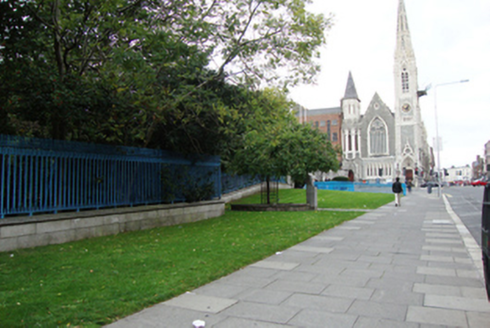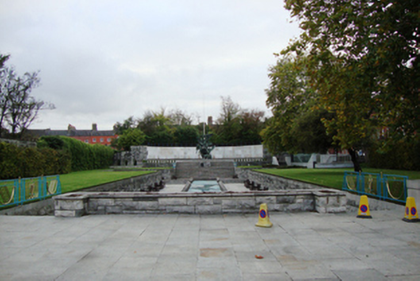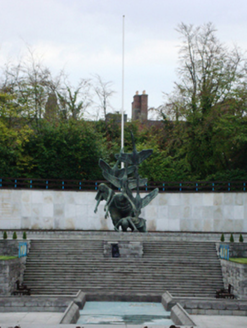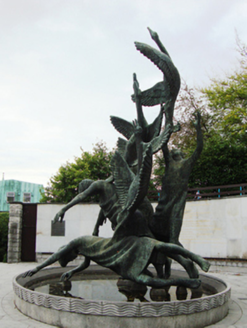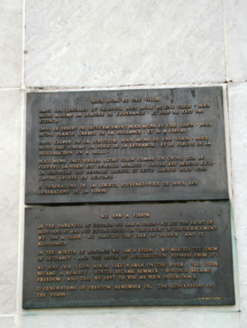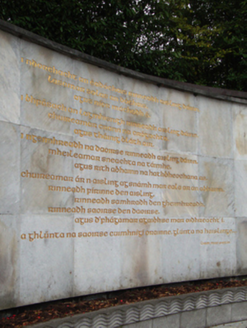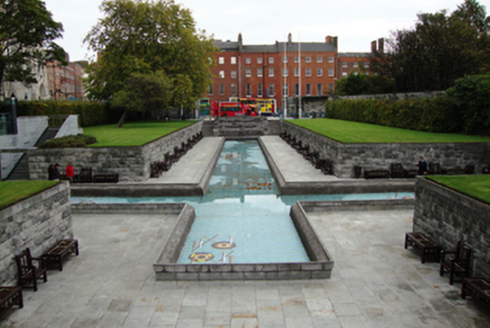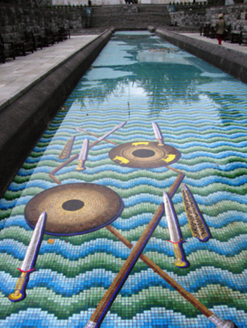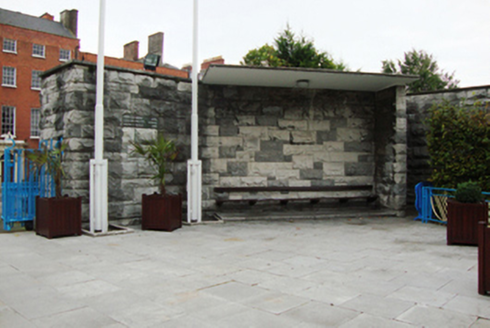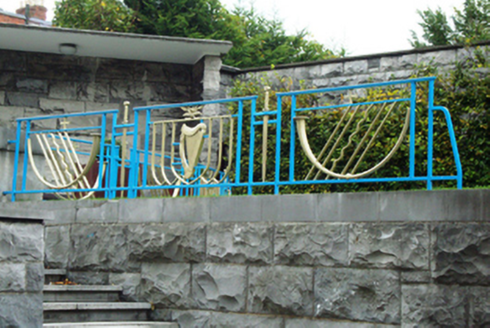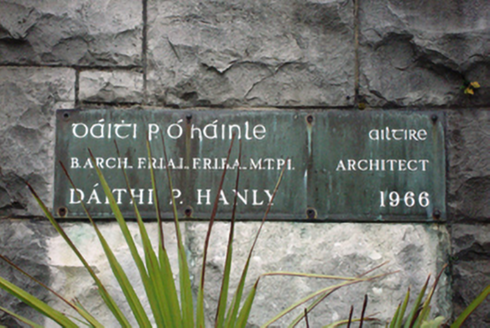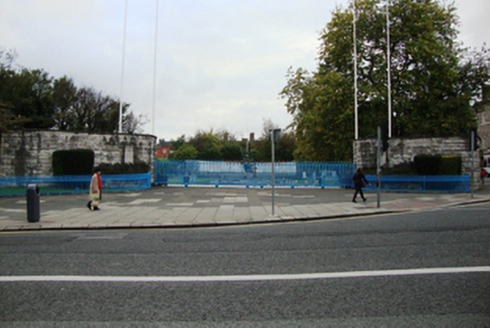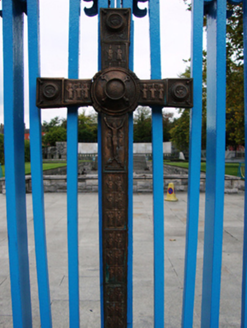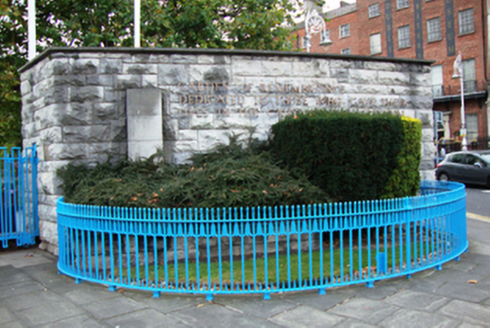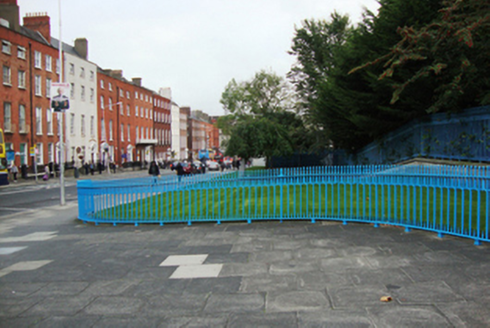Survey Data
Reg No
50010658
Rating
National
Categories of Special Interest
Architectural, Artistic, Cultural, Historical, Social
Original Use
Garden
In Use As
Garden
Date
1965 - 1970
Coordinates
315589, 235075
Date Recorded
01/12/2011
Date Updated
--/--/--
Description
National Garden of Remembrance, dated 1966, to designs of Dáithí Hanly, at north end of Parnell Square, having raised apse platform to west and sunken cruciform pool. Raised limestone paved semi-circular platform to west with monumental bronze group by Oisín Kelly, dated 1971, entitled ‘The Children of Lir’ set in small pool enclosed by low granite plinth wall with wave-form trim. Platform enclosed to west by marble-clad curved wall and pair of rock-faced limestone walls with inscribed gilt Gaelic lettering to centre, taken from ‘We Saw a Vision’ by Liam Mac Uistín, and two bronze plaques with French and English translations. Twenty-two stone steps lead to central sunken cruciform pool set on east-west axis, decorated with waves of blue mosaic tiles and repetitive mosaic motif of shields and spears (symbolising ancient custom of throwing weapons into water on cessation of hostilities). Low granite plinth wall encloses pool with cast concrete wave-form trim. Cruciform paved area encircling pool with rock-faced limestone ashlar retaining walls to lawns above. Secondary entrance to north side of gardens, built c.2005, with modern glazed terrace and two sets of stone steps descending to pool level accessed via stainless steel gate opposite Hugh Lane Gallery. Limestone paved platform to east, having two flights of limestone steps either side of three platforms with rock-faced limestone ashlar faces and benches. Two rock-faced limestone-clad wings to either side of principal east entrance, one containing tool store, other containing caretaker’s office, with concrete canopy facing garden sheltering benches. Stylized iron railings to upper platform at east of site with symbols of Brian Boru harp, Loughnashade trumpet, and Ballinderry sword. Iron entrance gate on roller with central bronze replica of processional Cross of Cloyne surmounted by words ‘GÁIRDÍN CUIMHNEACHÁIN’. Flanking masonry wings bearing text ‘GARDEN OF REMEMBRANCE / DEDICATED TO THOSE WHO GAVE THEIR / LIVES IN THE CAUSE FOR IRISH FREEDOM’, Irish translation to south wing. S-curved iron railings enclose both entrance wings. Cast-iron railings on moulded granite plinth wall enclose east, north and west sides of garden with lawn to east. Double cast-iron gates to south of west railings allowing vehicular access to rear of apse. Rock-faced limestone wall between Rotunda Hospital grounds and garden.
Appraisal
Parnell Square has its origins c.1750 as the New Gardens of the Lying-In Hospital, designed by Robert Stevenson and developed by Dr. Batholomew Mosse to raise funds for his charitable maternity hospital. In 1784, an Act of Parliament was passed to remove the wall surrounding the Gardens, introduce railings and street lighting and the gardens were re-named Rutland Square in honour of the Lord Lieutenant, the Duke of Rutland. The gardens were enhanced with the addition of the great round Assembly Rooms or Rotunda in 1764 (the former Ambassador cinema), and the construction of the new Assembly Rooms in 1784 to the designs of Richard Johnston (now the Gate Theatre). Under the 1785 Act of Parliament that created Rutland Square, the hospital was prevented from building further on the garden, but an extension was added in 1895 on Parnell Square West, while a Nurse’s Home designed by F.G. Hicks was built in 1940. In 1935 the Dublin Brigade Council of the Old IRA suggested to the Government that a site on the northern part of the Rotunda Gardens be converted into a memorial garden, marking the site where Óglaigh na nÉireann was founded in 1913 and where prisoners of 1916 had been held during Easter Week. The site was acquired from the Governors of the Rotunda Hospital in October 1939 at a cost of £2,000. World War Two and controversy delayed the construction of the park until 1964, but the Garden was completed in time for the 50th anniversary commemoration of the 1916 Rising. Rutland Square was renamed in honour of the political leader Charles Stewart Parnell in the same year. Hanley’s design drew heavily on Ireland’s Celtic past and made use of much religious iconography. The encroachment of the Rotunda Hospital buildings on the space once occupied by the eighteenth-century gardens means its legibility as a Georgian Square has been compromised. At a visit by Queen Elizabeth II in 2011, Hanley’s original intentions of the ceremonial use of the space were fulfilled with the placement of a wreath on the stone platform and a guard of honour in the apse overlooking the garden. The Garden of Remembrance provides a very public platform for the commemoration of those killed in the struggle for Irish Independence and is a unique symbolic expression of Irish nationhood. The emphasis on religious iconography and ancient Celtic motifs in Hanley’s design, coupled with Kelly’s bronze sculpture serves not only to effectively commemorate the dead but also to draw a parallel between them and the ancient warriors of the heroic, Celtic and pre-colonial past.
